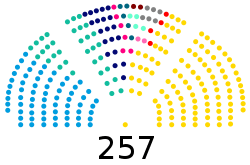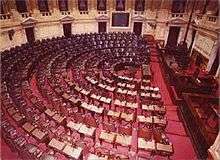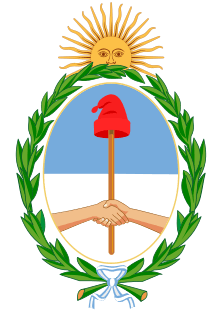Argentine Chamber of Deputies
| Argentine Chamber of Deputies Cámara de Diputados | |
|---|---|
| 2017–2019 period | |
 | |
| Type | |
| Type | |
| Leadership | |
1st Vice President | |
First Minority Leader | |
Second Minority Leader | |
| Structure | |
| Seats | 257 (List) |
 | |
Political groups |
Government (108)
Opposition (149)
|
| Elections | |
|
Party-list proportional representation D'Hondt method | |
Last election | 22 October 2017 |
Next election | 2019 |
| Meeting place | |
 | |
|
Chamber of Deputies, Congress Palace, Buenos Aires, Argentina | |
| Website | |
| Diputados | |
The Chamber of Deputies is the lower house of the Argentine National Congress. The Chamber holds exclusive rights to levy taxes; to draft troops; and to accuse the President, cabinet ministers, and members of the Supreme Court before the Senate.
Current composition
It has 257 seats and one-half of the members are elected every two years to serve four-year terms by the people of each district (23 provinces and the Autonomous City of Buenos Aires) using proportional representation, D'Hondt formula with a 3% of the district registered voters threshold, and the following distribution:
By province
| Province | Deputies | Population (2010) |
|---|---|---|
| Buenos Aires City | 25 | 2,890,151 |
| Buenos Aires | 70 | 15,625,084 |
| Catamarca | 5 | 367,828 |
| Chaco | 7 | 1,053,466 |
| Chubut | 5 | 506,668 |
| Córdoba | 18 | 3,304,825 |
| Corrientes | 7 | 993,338 |
| Entre Ríos | 9 | 1,236,300 |
| Formosa | 5 | 527,895 |
| Jujuy | 6 | 672,260 |
| La Pampa | 5 | 316,940 |
| La Rioja | 5 | 331,847 |
| Mendoza | 10 | 1,741,610 |
| Misiones | 7 | 1,097,829 |
| Neuquén | 5 | 550,334 |
| Río Negro | 5 | 633,374 |
| Salta | 7 | 1,215,207 |
| San Juan | 6 | 680,427 |
| San Luis | 5 | 431,588 |
| Santa Cruz | 5 | 272,524 |
| Santa Fe | 19 | 3,200,736 |
| Santiago del Estero | 7 | 896,461 |
| Tierra del Fuego | 5 | 126,190 |
| Tucumán | 9 | 1,448,200 |
By political groups
All data from official website.[2]
| Alliance | Party | Leader | |
|---|---|---|---|
| Cambiemos (108) (President: Mario Negri) |
Unión PRO (55) | Nicolás Massot | |
| Unión Cívica Radical (40) | Mario Negri | ||
| Coalición Cívica (10) | Elisa Carrió | ||
| Frente Cívico y Social de Catamarca (1) | Eduardo Brizuela del Moral | ||
| Partido por la Justicia Social (1) | Beatriz Ávila | ||
| Salta Somos Todos (1) | Alfredo Olmedo | ||
| Frente para la Victoria-PJ (65) (President: Agustín Rossi) |
Frente para la Victoria-PJ (64) | Agustín Rossi | |
| Concertación-FORJA (1) | Juan Manuel Pereyra | ||
| Argentina Federal (33) (President: Pablo Kosiner) |
Justicialista (18) | Pablo Kosiner | |
| Frente de la Concordia Misionero (5) | Jorge Daniel Franco | ||
| Córdoba Federal (4) | Martín Llaryora | ||
| Justicialista por Tucumán (3) | Pablo Raul Yedlin | ||
| Todos Juntos por San Juan (1) | Walberto Enrique Allende | ||
| Somos San Juan (1) | María Florencia Peñaloza Marianetti | ||
| Partido Bloquista de San Juan (1) | Graciela María Caselles | ||
| Frente Renovador UNA (21) (President: Graciela Camaño) |
Federal Unidos por una Nueva Argentina (18) | Graciela Camaño | |
| Cultura, Educación y Trabajo (1) | Jorge Taboada | ||
| Córdoba Trabajo y Producción (1) | Adriana Mónica Nazario | ||
| Trabajo y Dignidad (1) | Rosa Rosario Muñoz | ||
| Frente Cívico por Santiago (6) | Hugo Orlando Infante | ||
| En Marcha (5) (President: Leonardo Grosso) |
Peronismo para la Victoria (3) | Leonardo Grosso | |
| Libres del Sur (1) | Victoria Donda | ||
| Evolución Radical (3) | Martín Lousteau | ||
| Unidad Justicialista (4) | Ivana María Bianchi | ||
| PTS-Frente de Izquierda (2) | Nicolás del Caño | ||
| Elijo Catamarca (2) | Gustavo Arturo Saadi | ||
| One deputy parties (7) | |||
| Bloque Protectora (1) | José Luis Ramón | ||
| Frente Progresista Cívico y Social (1) | Luis Gustavo Contigiani | ||
| Frente de Izquierda y de los Trabajadores (1) | Romina del Plá | ||
| Movimiento Popular Neuquino (1) | Alma "Chani" Sapag | ||
| Nuevo Espacio Santafesino (1) | Alejandra Rodenas | ||
| Primero Argentina (1) | Alejandro Ramos | ||
| Somos Mendoza (1) | Omar Chafí Félix | ||
| Vacant (1)[1] | |||
Requirements
In order for an Argentine citizen to be elected to congress, they have to fulfil certain requirements: He or she has to be at least twenty five years old with at least four years of active citizenship and it has to be naturalized in the province that is being elected to or at least have two years of immediate residency in said province, according to art. 48 or the Argentine Constitution.
History
The Chamber of Deputies was provided for in the Constitution of Argentina, ratified on May 1, 1853. Eligibility requisites are that members be at least twenty-five years old, and have been a resident of the province they represent for at least four years; as congressional seats are elected at-large, members nominally represent their province, rather than a district.[3]
Otherwise patterned after Article One of the United States Constitution per legal scholar Juan Bautista Alberdi's treatise, Bases de la Constitución Argentina, the chamber was originally apportioned in one seat per 33,000 inhabitants. The constitution made no provision for a national census, however, and because the Argentine population doubled every twenty years from 1870 to 1930 as a result of immigration (disproportionately benefiting Buenos Aires and the Pampas area provinces), censuses were conducted generationally, rather than every decade, until 1947.[4]
Apportionment controversy
The distribution of the Chamber of Deputies is regulated since 1983 by Law 22.847, also called Ley Bignone, enacted by the last Argentine dictator, General Reynaldo Bignone, ahead of the 1983 general elections. This law established that, initially, each province shall have one deputy per 161,000 inhabitants, with standard rounding; after this is calculated, each province is granted three more deputies. If a province has fewer than five deputies, the number of deputies for that province is increased to reach that minimum.
Controversially, apportionment remains based on the 1980 population census, and has not been modified since 1983; national censuses since then have been conducted in 1991, 2001, and 2010. The minimum of five seat per province allots the smaller ones a disproportionately large representation, as well. Accordingly, this distribution does not reflect Argentina's current population balance.
Presidents of the Chamber
The President of the Chamber is elected by the majority caucus. The officeholders for this post since 1983 have been:
| Term began | Term ended | Officeholder | Party | Province |
|---|---|---|---|---|
| December 10, 1983 | April 3, 1989 | Juan Carlos Pugliese | UCR | |
| April 3, 1989 | July 8, 1989 | Leopoldo Moreau | UCR | |
| July 8, 1989 | December 10, 1999 | Alberto Pierri | PJ | |
| December 10, 1999 | December 10, 2001 | Rafael Pascual | UCR | |
| December 10, 2001 | December 10, 2005 | Eduardo Camaño | PJ | |
| December 10, 2005 | December 10, 2007 | Alberto Balestrini | FPV - PJ | |
| December 10, 2007 | December 6, 2011 | Eduardo Fellner | FPV - PJ | |
| December 6, 2011 | December 4, 2015 | Julián Domínguez | FPV - PJ | |
| December 4, 2015 | to date | Emilio Monzó | PRO-Cambiemos |
Current authorities
Leadership positions include:
| Title | Officeholder | Party | Province |
|---|---|---|---|
| Chamber President | Emilio Monzó | PRO-Cambiemos | |
| First Vice-President | José Luis Gioja | FPV-PJ | |
| Second Vice-President | Patricia Giménez | UCR | |
| Third Vice-President | Felipe Solá | PJ-FR | |
| Parliamentary Secretary | Eugenio Inchausti | ||
| Administrative Secretary | Florencia Romano | ||
| Coordinating Secretary | María Luz Alonso |
See also
References
- 1 2 The deputy Julio de Vido was suspended according to Article 70 of the National Constitution.
- ↑ Bloques e interbloques - Cámara de Diputados de la Nación Argentina
- ↑ Honorable Senado de la Nación: Constitución Nacional Archived 2012-05-13 at the Wayback Machine. (in Spanish)
- ↑ Indec: Historia de los censos (in Spanish)
External links
| Wikimedia Commons has media related to Parliaments of Argentina. |
